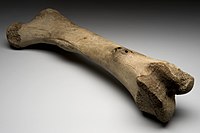
Photo from wikipedia
ABSTRACT Transplantation of bone marrow‐derived endothelial progenitor cells (BM‐EPCs) has been used as a therapeutic strategy for vascular repair. However, it remains controversial whether BM‐EPCs exhibit clonal endothelial colony‐forming cell… Click to show full abstract
ABSTRACT Transplantation of bone marrow‐derived endothelial progenitor cells (BM‐EPCs) has been used as a therapeutic strategy for vascular repair. However, it remains controversial whether BM‐EPCs exhibit clonal endothelial colony‐forming cell (ECFC) capacity, a characteristic of true EPCs. The aim of this study was to isolate and explore the cellular properties of BM‐ECFCs. We isolated BM‐ECFCs from rat bone marrow with high purity via an optimized method. This approach involved the removal of selective colonies based on the conventional differential adhesive culture method used to isolate ECFCs from peripheral and umbilical cord blood. Our results indicate that primary colony BM‐ECFCs display a panel of surface antigen markers consistent with endothelial cells. These BM‐ECFCs coexpress CD34, CD133, and VEGFR2 at high levels, and these levels decrease with passaging. These cells have high potential for proliferation, migration, and formation of capillary‐like structures on Matrigel, and these abilities are retained during ex vivo expansion. Furthermore, BM‐ECFCs cultured with 10% or 20% fetal bovine serum demonstrated two different patterns of spontaneous capillary‐like structure formation. These results provide a foundation for isolation of ECFCs from human bone marrow for autologous cell transplantation and tissue engineering applications in the future. HIGHLIGHTSBM‐ECFCs are isolated from rat bone marrow with high purity by an optimized method.Primary colony BM‐ECFCs highly display CD34+/CD133+/VEGFR2+.BM‐ECFCs possess and maintain pronounced angiogenic abilities during the expansion.BM‐ECFCs spontaneously form tube‐like structures during culture without Matrigel.
Journal Title: Experimental Cell Research
Year Published: 2018
Link to full text (if available)
Share on Social Media: Sign Up to like & get
recommendations!